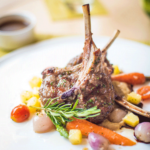 Notes From The Concrete Terroir: To Rosé Or Not To Rosé?!
Notes From The Concrete Terroir: To Rosé Or Not To Rosé?!
First off, I may not need to state it, but nevertheless, at the risk of mentioning the obvious, I’ll tap it out anyway: We’re still in the middle of a global pandemic. The coronavirus. covid. The plague. Whatever you may want to label it. The calendar might have moved to 2021, and there might be some very promising developments in our midst (a vaccine being rolled out…a new President and accompanying administration in office…it being, well, no longer 2020 hehe), but even so, we’re still not out of the grips of this awful, dire health crisis we’ve all been in since, gulp nearly a full year ago. Secondly, if all that weren’t enough, again referring to the calendar, we’re now smack dab in the throngs of winter. February, and although, spring is in sight, the days are still short and bone chilling cold, and the nights are still filled with huddling under the covers. Actually, come to think of it, the days might have a bit of that, too, if one finds themselves working from home. Well, it doesn’t take a genius or scientist, or for that matter, a doctor at the CDC to figure out that with all these factors forming a perfect storm of emotional crap, what is needed is some kind of coping mechanism to deal. And by that I mean, uh, alcohol! Because, if nothing else, alcohol comes in handy when it’s, err, in hand, especially, during times like these. Literally. Figuratively. Yearly. Monthly. Weekly. Daily. Nightly. Hourly. Routinely. And just what exactly alcoholic beverages should be in that handy hand could be open to debate. I can’t speak for you, but I for one have a glass of Rosé in mind/mine. And with that, welcome to the subject of this, the latest installment of Notes From The Concrete Terroir, which asks the eternal, existential question: To Rosé Or Not To Rosé?
Once thought of as a sweet and cheap way to sip away spring and summer, Rosé as just a mere seasonal staple is no longer. “Rosé all day” many of us have heard, and there is even a vineyard that boasts that moniker on its label. But I’ll take it a step further, even 364+ and say, “How about, Rosé *Every” Day?!” Case in point:

As stated, it’s the middle of winter, and we are all, unfortunately (understatement), still stuck in the middle of a global health crisis. But while it is here, and we are having to deal with its consequences, such as quarantining, and social distancing, and one where we cannot see or spend time with most of our nearest and dearest short of the cold indifferent confines of a phone or computer screen, the best thing I can think of to drink is the pale pink stuff more commonly referred to as Rosé. Think of it as cheeriness in a bottle. Hope in a glass. A new better world on your palette and in your nose, it’s aromatic goodness warming your insides with floral and stoned, flinty fruit.
Did you know that Rosé in some circles is considered to be the oldest known type of wine? Yes, indeed. And just what exactly makes a wine a Rosé? For the unfamiliar, Rosé is a type of wine that incorporates some of the color from the grape skins, but not enough to qualify it as a red wine.
There are generally three different methods Rosé is made: via skin contact (the most straightforward way), as the French say, saignée, and then there is blending.

With the skin contact method, it is exactly as it sounds, darker, more black-skinned grapes are crushed and the skins are allowed to remain in contact with the juice for a short period—typically two to twenty hours. The grape must is then pressed and the skins discarded, rather than left in contact throughout fermentation (as with red wine making). The longer the skins are left in contact with the juice, the more intense the color of the final wine.
When a winemaker desires to impart more tannin and color to red wine, some of the pink juice from the must (the freshly crushed fruit juice that contains the skins, seeds, and stems of the fruit), can be removed at an early stage in what is known as the Saignée. The red wine remaining in the vats is intensified as a result of the bleeding, because the volume of juice in the must is reduced, and the must involved in the maceration becomes more concentrated. The pink juice that is removed can be fermented separately to produce Rosé.
Lastly, there is the blended method, in which the simple mixing of red wine into white wine occurs to impart a more lighter color. This method is uncommon and generally is discouraged in most wine growing regions, especially in France, where it is forbidden by law, except for Champagne. And even in Champagne, several high-end producers do not use this method but rather the saignée method.
As for where it is made, Rosé is produced in most of the usual wine-making countries and/or regions you’d expect: France, Italy (called “Rosato”), Spain (called “Rosado”), Portugal, Germany, California and New York in the United States, New Zealand, Australia, South Africa, Argentina, Chile, and so on. It can be made as both a still wine, as well as a sparkling one.
And it is here that it must be noted that while there are still plenty of inexpensive and sweeter rosés around, gone are the times where they are the norm. Nowadays, there are plenty of very dry and acidic options out there. Ones where minerality and complexity co-exists with juicy and deliciousness.

Personally, my favorite rosés typically come from Provence, France. This is an area very much distinctly known for its rosé production, and is every bit the *leader of bringing it to the rest of the World for all of us to enjoy (some recent wine industry estimates have France producing 34% of all rose wine in the World, of which 40% comes from Provence).
One rosé from Provence in particular that has been making these dreary times at least a smidge more tolerable is Domaine de Belambree (…Well, perhaps even more than a smidge…!). Composed of the classic Provencal grape triumvirate of Grenache/Syrah/Cinsault, this rosé is exceptional. Even by Provence standards. Pale-ish in color almost like a faded peach getting kissed by late afternoon sun, it is dry, bright, and expressive with plenty of minerality and red berry juiciness that never overpowers. In a word, refreshing comes to mind.
And I can’t remember when being “refreshed” by anything was ever more essential.
 Peter “Blue” Zusman is an artist and wine & spirits enthusiast living in Manhattan’s Lower East Side. He places equal importance on both a finely-aged single malt and a medium bodied, earthy red. Summer is always about Provence. He was formerly a contributing wine writer at grapecollective.com.
Peter “Blue” Zusman is an artist and wine & spirits enthusiast living in Manhattan’s Lower East Side. He places equal importance on both a finely-aged single malt and a medium bodied, earthy red. Summer is always about Provence. He was formerly a contributing wine writer at grapecollective.com.
Photo credit: Vincenzo Landino on Unsplash



